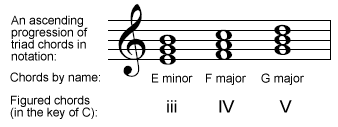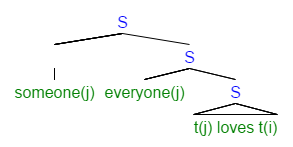|
Deep Structure
Deep structure and surface structure (also D-structure and S-structure although those abbreviated forms are sometimes used with distinct meanings) are concepts used in linguistics, specifically in the study of syntax in the Chomskyan tradition of transformational generative grammar. The deep structure of a linguistic expression is a theoretical construct that seeks to unify several related structures. For example, the sentences "Pat loves Chris" and "Chris is loved by Pat" mean roughly the same thing and use similar words. Some linguists, Chomsky in particular, have tried to account for this similarity by positing that these two sentences are distinct ''surface forms'' that derive from a common (or very similar) deep structure. Origin Chomsky coined and popularized the terms "deep structure" and "surface structure" in the early 1960s. American linguist Sydney Lamb wrote in 1975 that Chomsky "probably orrowedthe term from Hockett". American linguist Charles Hockett first used ... [...More Info...] [...Related Items...] OR: [Wikipedia] [Google] [Baidu] |
Linguistics
Linguistics is the scientific study of language. The areas of linguistic analysis are syntax (rules governing the structure of sentences), semantics (meaning), Morphology (linguistics), morphology (structure of words), phonetics (speech sounds and equivalent gestures in sign languages), phonology (the abstract sound system of a particular language, and analogous systems of sign languages), and pragmatics (how the context of use contributes to meaning). Subdisciplines such as biolinguistics (the study of the biological variables and evolution of language) and psycholinguistics (the study of psychological factors in human language) bridge many of these divisions. Linguistics encompasses Outline of linguistics, many branches and subfields that span both theoretical and practical applications. Theoretical linguistics is concerned with understanding the universal grammar, universal and Philosophy of language#Nature of language, fundamental nature of language and developing a general ... [...More Info...] [...Related Items...] OR: [Wikipedia] [Google] [Baidu] |
Minimalist Program
In linguistics, the minimalist program is a major line of inquiry that has been developing inside generative grammar since the early 1990s, starting with a 1993 paper by Noam Chomsky. Following Imre Lakatos's distinction, Chomsky presents minimalism as a research program, program, understood as a mode of inquiry that provides a conceptual framework which guides the development of linguistic theory. As such, it is characterized by a broad and diverse range of research directions. For Chomsky, there are two basic Minimalist grammar, minimalist questions—What is language? and Why does it have the properties it has?—but the answers to these two questions can be framed in any theory.Boeckx, Cedric ''Linguistic Minimalism. Origins, Concepts, Methods and Aims'', pp. 84 and 115. Conceptual framework Goals and assumptions Minimalism is an approach developed with the goal of understanding the nature of language. It models a speaker's knowledge of language as a computational syste ... [...More Info...] [...Related Items...] OR: [Wikipedia] [Google] [Baidu] |
Syntactic Transformation
In linguistics, syntax ( ) is the study of how words and morphemes combine to form larger units such as phrases and sentences. Central concerns of syntax include word order, grammatical relations, hierarchical sentence structure (constituency), agreement, the nature of crosslinguistic variation, and the relationship between form and meaning (semantics). Diverse approaches, such as generative grammar and functional grammar, offer unique perspectives on syntax, reflecting its complexity and centrality to understanding human language. Etymology The word ''syntax'' comes from the ancient Greek word , meaning an orderly or systematic arrangement, which consists of (''syn-'', "together" or "alike"), and (''táxis'', "arrangement"). In Hellenistic Greek, this also specifically developed a use referring to the grammatical order of words, with a slightly altered spelling: . The English term, which first appeared in 1548, is partly borrowed from Latin () and Greek, though the Latin t ... [...More Info...] [...Related Items...] OR: [Wikipedia] [Google] [Baidu] |
Aspects Of The Theory Of Syntax
''Aspects of the Theory of Syntax'' (known in linguistic circles simply as ''Aspects'') is a book on linguistics written by American linguist Noam Chomsky, first published in 1965. In ''Aspects'', Chomsky presented a deeper, more extensive reformulation of transformational generative grammar (TGG), a new kind of syntactic theory that he had introduced in the 1950s with the publication of his first book, '' Syntactic Structures''. ''Aspects'' is widely considered to be the foundational document and a proper book-length articulation of Chomskyan theoretical framework of linguistics.Gallego and Ott 2015 : 249 It presented Chomsky's epistemological assumptions with a view to establishing linguistic theory-making as a formal (i.e. based on the manipulation of symbols and rules) discipline comparable to physical sciences, i.e. a domain of inquiry well-defined in its nature and scope. From a philosophical perspective, it directed mainstream linguistic research away from behaviorism, con ... [...More Info...] [...Related Items...] OR: [Wikipedia] [Google] [Baidu] |
Underlying Representation
In some models of phonology as well as morphophonology in the field of linguistics, the underlying representation (UR) or underlying form (UF) of a word or morpheme is the abstract form that a word or morpheme is postulated to have before any phonological rules have been applied to it. In contrast, a surface representation is the phonetic representation of the word or sound. The concept of an underlying representation is central to generative grammar. If more phonological rules apply to the same underlying form, they can apply wholly independently of each other or in a feeding or counterbleeding order. The underlying representation of a morpheme is considered to be invariable across related forms (except in cases of suppletion), despite alternations among various allophones on the surface. Examples In many cases, the underlying form is simply the phonemic form. For example, in many varieties of American English, the phoneme in a word like ''wet'' can surface either as an ... [...More Info...] [...Related Items...] OR: [Wikipedia] [Google] [Baidu] |
Chord Progression
In a musical composition, a chord progression or harmonic progression (informally chord changes, used as a plural, or simply changes) is a succession of chords. Chord progressions are the foundation of harmony in Western musical tradition from the common practice era of Classical music to the 21st century. Chord progressions are the foundation of popular music styles (e.g., pop music, rock music), traditional music, as well as genres such as blues and jazz. In these genres, chord progressions are the defining feature on which melody and rhythm are built. In tonal music, chord progressions have the function of either establishing or otherwise contradicting a tonality, the technical name for what is commonly understood as the " key" of a song or piece. Chord progressions, such as the extremely common chord progression I-V-vi-IV, are usually expressed by Roman numerals in Classical music theory. In many styles of popular and traditional music, chord progressions are expressed ... [...More Info...] [...Related Items...] OR: [Wikipedia] [Google] [Baidu] |
Schenkerian Analysis
Schenkerian analysis is a method of musical analysis, analyzing tonal music based on the theories of Heinrich Schenker (1868–1935). The goal is to demonstrate the organic coherence of the work by showing how the "foreground" (all notes in the score) relates to an abstracted Fundamental structure, deep structure, the ''Ursatz''. This primal structure is roughly the same for any tonal work, but a Schenkerian analysis shows how, in each individual case, that structure develops into a unique work at the foreground. A key theoretical concept is "tonal space". The intervals between the notes of the tonic triad in the background form a ''tonal space'' that is filled with passing and neighbour tones, producing new triads and new tonal spaces that are open for further elaborations until the "surface" of the work (the score) is reached. The analysis uses a specialized symbolic form of musical notation. Although Schenker himself usually presents his analyses in the generative direction, star ... [...More Info...] [...Related Items...] OR: [Wikipedia] [Google] [Baidu] |
Linguistics Wars
The linguistics wars were extended disputes among American theoretical linguists that occurred mostly during the 1960s and 1970s, stemming from a disagreement between Noam Chomsky and several of his associates and students. The debates started in 1967 when linguists Paul Postal, John R. Ross, George Lakoff, and James D. McCawley —self-dubbed the "Four Horsemen of the Apocalypse"—proposed an alternative approach in which the relation between semantics and syntax is viewed differently, which treated Deep structure and surface structure, deep structures as meaning rather than syntactic objects. While Chomsky and other generative grammar, generative grammarians argued that meaning is driven by an underlying syntax, generative semanticists posited that syntax is shaped by an underlying meaning. This intellectual divergence led to two competing frameworks in generative semantics and interpretive semantics. Eventually, generative semantics spawned a different linguistic paradigm, kno ... [...More Info...] [...Related Items...] OR: [Wikipedia] [Google] [Baidu] |
Generative Semantics
Generative semantics was a research program in theoretical linguistics which held that syntax, syntactic structures are computed on the basis of meaning (linguistics), meanings rather than the other way around. Generative semantics developed out of transformational-generative grammar, transformational generative grammar in the mid-1960s, but stood in opposition to it. The period in which the two research programs coexisted was marked by intense and often personal clashes now known as the linguistics wars. Its proponents included John R. Ross, Haj Ross, Paul Postal, James McCawley, and George Lakoff, who dubbed themselves "The Four Horsemen of the Apocalypse". Generative semantics is no longer practiced under that name, though many of its central ideas have blossomed in the cognitive linguistics tradition. It is also regarded as a key part of the intellectual heritage of head-driven phrase structure grammar (HPSG) and construction grammar, and some of its insights live on in mains ... [...More Info...] [...Related Items...] OR: [Wikipedia] [Google] [Baidu] |
Robert May (linguist)
Robert, Bob or Rob May may refer to: * Robert May (cook) (1588 – c. 1664), English chef * Robert May (producer) American filmmaker, producer and director * Robert May, founder in 1694 of Robert May's School, Odiham, Hampshire, England * Robert C. May, American philosopher * Robert G. May, American academic administrator * Robert H. May (1822–1903), mayor of Augusta, Georgia * Robert Hobart May (c.1801–?1832), Aboriginal Tasmanian massacre survivor * Robert L. May (1905–1976), creator of Rudolph the Red-Nosed Reindeer * Robert P. May, interim CEO of HealthSouth Corporation * Robert May, Baron May of Oxford (1936–2020), Australian biologist * Bob May (actor) (1939–2009), American actor * Bob May (golfer) Robert Anthony May (born October 6, 1968) is an American professional golfer. He is most notable for losing to Tiger Woods in a three-hole playoff for the 2000 PGA Championship at Valhalla Golf Club, Valhalla. Early life and amateur career May w ... (born 1968), ... [...More Info...] [...Related Items...] OR: [Wikipedia] [Google] [Baidu] |
Logical Form (linguistics)
In generative grammar and related approaches, the logical form (LF) of a linguistic expression is the variant of its syntactic structure which undergoes formal semantics (linguistics), semantic interpretation. It is distinguished from ''phonetic form'', the structure which corresponds to a sentence's pronunciation. These separate mental representation, representations are postulated in order to explain the ways in which an expression's meaning can be partially independent of its pronunciation, e.g. scope (formal semantics)#Scope ambiguity, scope ambiguities. LF is the cornerstone of the classic generative view of the syntax-semantics interface. However, it is not used in Lexical Functional Grammar and Head-Driven Phrase Structure Grammar, as well as some modern variants of the generative approach. Syntax interfacing with semantics The notion of Logical Form was originally invented for the purpose of determining Quantifier (linguistics), quantifier scope. As the theory around t ... [...More Info...] [...Related Items...] OR: [Wikipedia] [Google] [Baidu] |





